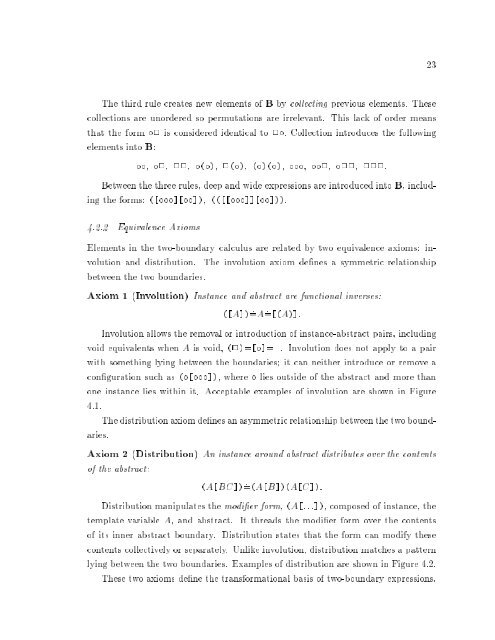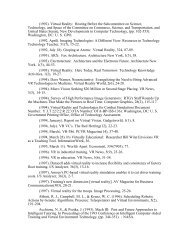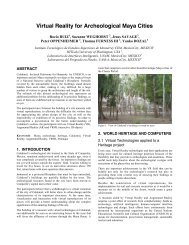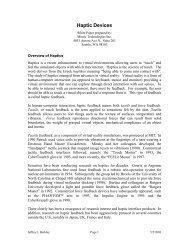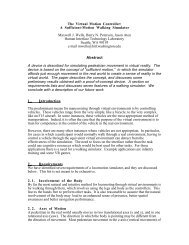A Calculus of Number Based on Spatial Forms - University of ...
A Calculus of Number Based on Spatial Forms - University of ...
A Calculus of Number Based on Spatial Forms - University of ...
Create successful ePaper yourself
Turn your PDF publications into a flip-book with our unique Google optimized e-Paper software.
23<br />
The third rule creates new elements <str<strong>on</strong>g>of</str<strong>on</strong>g> B by collecting previous elements. These<br />
collecti<strong>on</strong>s are unordered so permutati<strong>on</strong>s are irrelevant. This lack <str<strong>on</strong>g>of</str<strong>on</strong>g> order means<br />
that the form 2 is c<strong>on</strong>sidered identical to 2: Collecti<strong>on</strong> introduces the following<br />
elements into B:<br />
; 2; 22; (); 2(); ()(); ; 2; 22; 222:<br />
Between the three rules, deep and wide expressi<strong>on</strong>s are introduced into B, including<br />
the forms: ([][]); (([[]][])):<br />
4.2.2 Equivalence Axioms<br />
Elements in the two-boundary calculus are related by two equivalence axioms: involuti<strong>on</strong><br />
and distributi<strong>on</strong>. The involuti<strong>on</strong> axiom denes a symmetric relati<strong>on</strong>ship<br />
between the two boundaries.<br />
Axiom 1 (Involuti<strong>on</strong>) Instance and abstract are functi<strong>on</strong>al inverses:<br />
([A]) =A : =[(A)]:<br />
:<br />
Involuti<strong>on</strong> allows the removal or introducti<strong>on</strong> <str<strong>on</strong>g>of</str<strong>on</strong>g> instance-abstract pairs, including<br />
void equivalents when A is void, (2)=[]= . Involuti<strong>on</strong> does not apply to a pair<br />
with something lying between the boundaries; it can neither introduce or remove a<br />
c<strong>on</strong>gurati<strong>on</strong> such as([]); where lies outside <str<strong>on</strong>g>of</str<strong>on</strong>g> the abstract and more than<br />
<strong>on</strong>e instance lies within it. Acceptable examples <str<strong>on</strong>g>of</str<strong>on</strong>g> involuti<strong>on</strong> are shown in Figure<br />
4.1.<br />
The distributi<strong>on</strong> axiom denes an asymmetric relati<strong>on</strong>ship between the two boundaries.<br />
Axiom 2 (Distributi<strong>on</strong>) An instance around abstract distributes over the c<strong>on</strong>tents<br />
<str<strong>on</strong>g>of</str<strong>on</strong>g> the abstract:<br />
(A[BC]) =(A[B])(A[C]):<br />
:<br />
Distributi<strong>on</strong> manipulates the modier form, (A[:::]); composed <str<strong>on</strong>g>of</str<strong>on</strong>g> instance, the<br />
template variable A, and abstract. It threads the modier form over the c<strong>on</strong>tents<br />
<str<strong>on</strong>g>of</str<strong>on</strong>g> its inner abstract boundary. Distributi<strong>on</strong> states that the form can modify these<br />
c<strong>on</strong>tents collectively or separately. Unlike involuti<strong>on</strong>, distributi<strong>on</strong> matches a pattern<br />
lying between the two boundaries. Examples <str<strong>on</strong>g>of</str<strong>on</strong>g> distributi<strong>on</strong> are shown in Figure 4.2.<br />
These two axioms dene the transformati<strong>on</strong>al basis <str<strong>on</strong>g>of</str<strong>on</strong>g> two-boundary expressi<strong>on</strong>s.


